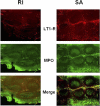Leukotriene modifier therapy for mild sleep-disordered breathing in children
- PMID: 15879419
- PMCID: PMC2718474
- DOI: 10.1164/rccm.200408-1064OC
Leukotriene modifier therapy for mild sleep-disordered breathing in children
Abstract
Background: Children with mild sleep-disordered breathing (SDB), who may not be recommended for adenotonsillectomy, frequently exhibit neurocognitive and behavioral morbidity, and may benefit from alternative therapeutic interventions, such as leukotriene modifier therapy.
Methods: Twenty-four children with SDB completed an open-label intervention study for 16 weeks with daily montelukast therapy. Sleep studies and adenoid size estimates from lateral X-ray films of the neck were obtained before and after treatment. In a parallel study, adenoid and tonsillar tissues from children with obstructive sleep apnea or recurrent throat infections were subjected to quantitative polymerase chain reaction, immunohistochemistry, and Western blotting for gene and protein expression of leukotriene receptors LT1-R and LT2-R, and for concentrations of LTB4 and LTC4/D4/E4.
Results: Montelukast treatment induced significant reductions in adenoid size and respiratory-related sleep disturbances, which were absent in 16 children with SDB who did not receive treatment. LT1-R and LT2-R mRNA was similarly abundant in adenoid tissues, but increased LT1-R and LT2-R protein expression and higher levels of LTB4 and LTC4/D4/E4 emerged in children with obstructive sleep apnea.
Conclusions: Oral therapy with a leukotriene modifier appears to be associated with improved breathing during sleep. Double-blind, placebo-controlled trials will be needed to corroborate current findings and solidly establish antiinflammatory strategies, such as leukotriene modifiers, as therapeutic alternatives in children with SDB too mild to justify referral for adenotonsillectomy.
Figures




Comment in
-
Is it time to consider a new treatment for children with sleep-disordered breathing?Am J Respir Crit Care Med. 2005 Aug 1;172(3):264-5. doi: 10.1164/rccm.2505006. Am J Respir Crit Care Med. 2005. PMID: 16040789 No abstract available.
-
Assessing the role of antiinflammatory medications in children with mild sleep-disordered breathing.Am J Respir Crit Care Med. 2006 Feb 1;173(3):358; author reply 358-9. doi: 10.1164/ajrccm.173.3.358. Am J Respir Crit Care Med. 2006. PMID: 16436369 No abstract available.
References
-
- Kaditis AG, Finder J, Alexopoulos EI, Starantzis K, Tanou K, Gampeta S, Agorogiannis E, Christodoulou S, Pantazidou A, Gourgoulianis K, et al. Sleep-disordered breathing in 3,680 Greek children. Pediatr Pulmonol 2004;37:499–509. - PubMed
-
- Arens R, McDonough JM, Corbin AM, Rubin NK, Carroll ME, Pack AI, Liu J, Udupa JK. Upper airway size analysis by magnetic resonance imaging of children with obstructive sleep apnea syndrome. Am J Respir Crit Care Med 2003;167:65–70. - PubMed
-
- Rosen CL. Racial differences in the diagnosis of childhood obstructive sleep apnea (OSA). Am J Respir Crit Care Med 1998;157:A535.
-
- Frank Y, Kravath RE, Pollak CP, Weitzman ED. Obstructive sleep apnea and its therapy: clinical and polysomnographic manifestations. Pediatrics 1983;71:737–742. - PubMed
-
- Tal A, Leiberman A, Margulis G, Sofer S. Ventricular dysfunction in children with obstructive sleep apnea: radionuclide assessment. Pediatr Pulmonol 1988;4:139–143. - PubMed
Publication types
MeSH terms
Substances
Grants and funding
LinkOut - more resources
Full Text Sources
Medical

